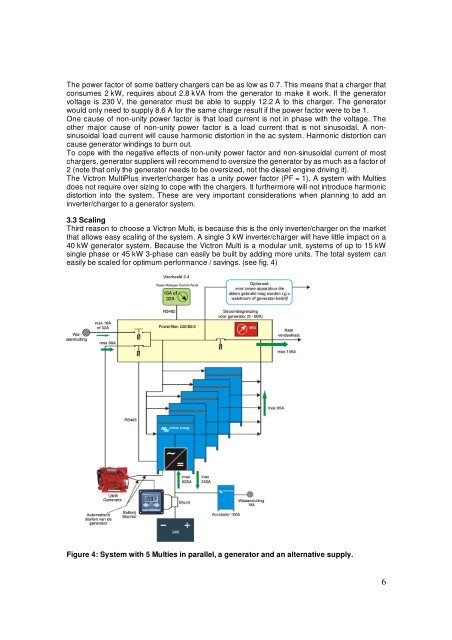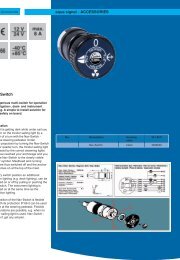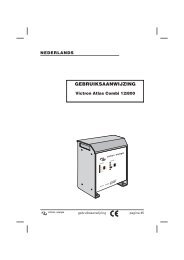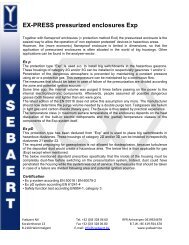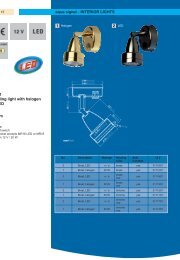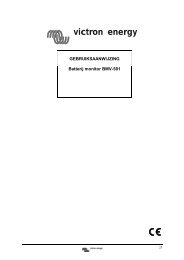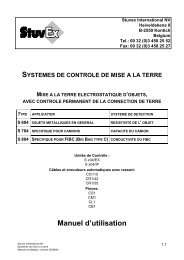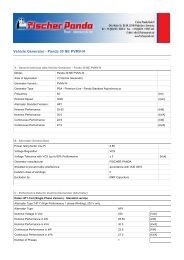Using the Phoenix MultiPlus to reduce operating cost of a ... - Ysebaert
Using the Phoenix MultiPlus to reduce operating cost of a ... - Ysebaert
Using the Phoenix MultiPlus to reduce operating cost of a ... - Ysebaert
You also want an ePaper? Increase the reach of your titles
YUMPU automatically turns print PDFs into web optimized ePapers that Google loves.
The power fac<strong>to</strong>r <strong>of</strong> some battery chargers can be as low as 0.7. This means that a charger thatconsumes 2 kW, requires about 2.8 kVA from <strong>the</strong> genera<strong>to</strong>r <strong>to</strong> make it work. If <strong>the</strong> genera<strong>to</strong>rvoltage is 230 V, <strong>the</strong> genera<strong>to</strong>r must be able <strong>to</strong> supply 12.2 A <strong>to</strong> this charger. The genera<strong>to</strong>rwould only need <strong>to</strong> supply 8.6 A for <strong>the</strong> same charge result if <strong>the</strong> power fac<strong>to</strong>r were <strong>to</strong> be 1.One cause <strong>of</strong> non-unity power fac<strong>to</strong>r is that load current is not in phase with <strong>the</strong> voltage. Theo<strong>the</strong>r major cause <strong>of</strong> non-unity power fac<strong>to</strong>r is a load current that is not sinusoidal. A nonsinusoidalload current will cause harmonic dis<strong>to</strong>rtion in <strong>the</strong> ac system. Harmonic dis<strong>to</strong>rtion cancause genera<strong>to</strong>r windings <strong>to</strong> burn out.To cope with <strong>the</strong> negative effects <strong>of</strong> non-unity power fac<strong>to</strong>r and non-sinusoidal current <strong>of</strong> mostchargers, genera<strong>to</strong>r suppliers will recommend <strong>to</strong> oversize <strong>the</strong> genera<strong>to</strong>r by as much as a fac<strong>to</strong>r <strong>of</strong>2 (note that only <strong>the</strong> genera<strong>to</strong>r needs <strong>to</strong> be oversized, not <strong>the</strong> diesel engine driving it).The Victron <strong>MultiPlus</strong> inverter/charger has a unity power fac<strong>to</strong>r (PF = 1). A system with Multiesdoes not require over sizing <strong>to</strong> cope with <strong>the</strong> chargers. It fur<strong>the</strong>rmore will not introduce harmonicdis<strong>to</strong>rtion in<strong>to</strong> <strong>the</strong> system. These are very important considerations when planning <strong>to</strong> add aninverter/charger <strong>to</strong> a genera<strong>to</strong>r system.3.3 ScalingThird reason <strong>to</strong> choose a Victron Multi, is because this is <strong>the</strong> only inverter/charger on <strong>the</strong> marketthat allows easy scaling <strong>of</strong> <strong>the</strong> system. A single 3 kW inverter/charger will have little impact on a40 kW genera<strong>to</strong>r system. Because <strong>the</strong> Victron Multi is a modular unit, systems <strong>of</strong> up <strong>to</strong> 15 kWsingle phase or 45 kW 3-phase can easily be built by adding more units. The <strong>to</strong>tal system caneasily be scaled for optimum performance / savings. (see fig. 4)Figure 4: System with 5 Multies in parallel, a genera<strong>to</strong>r and an alternative supply.6


